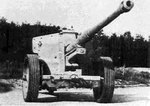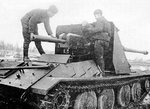Navigation
Install the app
How to install the app on iOS
Follow along with the video below to see how to install our site as a web app on your home screen.
Note: This feature may not be available in some browsers.
More options
You are using an out of date browser. It may not display this or other websites correctly.
You should upgrade or use an alternative browser.
You should upgrade or use an alternative browser.
Anti-tank weapons
- Thread starter Erich
- Start date
Ad: This forum contains affiliate links to products on Amazon and eBay. More information in Terms and rules
More options
Who Replied?Kongo Otto
Airman
plan_D said:The 128mm anti-tank cannon you showed a picture of, Kongo, is a PaK44 128mm not PaK43 - as there was no PaK43 128mm. PaK43 was an 88mm cannon.
Thats correct.Was my mistake.I´m sorry.
Greetings from Germany
Kongo Otto
trackend
Chief Master Sergeant
Thats alright Kongo we can't all be as perfect as old Plan D 
trackend
Chief Master Sergeant
Iv'e never seen a studded tank other than a lee grant.
trackend
Chief Master Sergeant
Steady on D you're starting to sound like an Anorak
I was quipping
I was quipping
DaveB.inVa
Airman 1st Class
- 225
- Dec 20, 2004
Heres a Boys .55 caliber anti-tank rifle used in WWII. It wasn't really effective at all against German tanks but worked pretty well against Japanese tanks. It weighed 36lbs and fired a steel core armor piercing round at 3250 fps penetrating over 0.75" steel at over 300 yards.
Attachments
trackend
Chief Master Sergeant
I thought I would include the sticky bomb after all as it was ment for use against armour although all the ex squaddies i've spoken to who used them said that no one told them that they contained nitro if they had none of them would have been so enthusiastic in whacking them on the sides on their intended targets .
Nº 74 ST Grenade
(Sticky Grenade)
Particulars:
Weight: 2 lbs. 4 ozs.
Fuze: Time
Delay: 5 sec.
The Nº 74 Grenade (Sticky Bomb) was designed as an anti-tank grenade and was disliked by everybody who ever came across it.
The grenade consisted of a glass ball on the end of a bakelite (plastic) handle. Inside the glass ball was an explosive filling whilst on the outside was a very sticky adhesive covering. Until used, this adhesive covering was encased in a metal outer casing.
Due to the use of glass in this grenade, they were fragile and travelled badly. Quite often the glass would crack in transit, causing the explosive to start leaking out. This explosive which leaked out was not very sensitive to friction but was very sensitive to impact and detonation could occur if the exposed explosive received a blow due to careless handling.
To use the grenade, you remove the case release pin (not the pin marked 'DANGER'). This allows the metal protective casing to fall free, exposing the adhesive coating. You then grip the handle and safety lever and remove the safety pin (marked 'DANGER'). The grenade is now ready to either throw or attach to the target.
This is where the sticky bomb is most dangerous! Whilst attempting to throw it, the grenade could stick to the wearers' clothing!
If the thrower has not let go of the safety lever, he has to try and remove the item of clothing without letting go of the lever.
If the thrower has let go of the lever, he has 5 second to remove the item of clothing and get a safe distance away from the bomb.
When this happened, it tended to end up stuck to the throwers' trousers - with the uniform which was worn at the time, to remove his trousers (which were held up by braces) the thrower would have to remove any equipment (belt, ammunition pouches, etc.) followed by his Battle Dress blouse (jacket). He would then have to try and take his trousers off over his boots - all in less than 5 seconds!
You may ask why the thrower could not just pull the grenade off of his clothing. They could try this but the adhesive coating was designed to allow the grenade, which weighed 2¼ lbs (1 Kg), to stick to the side of a tank.
Nº 74 ST Grenade
(Sticky Grenade)
Particulars:
Weight: 2 lbs. 4 ozs.
Fuze: Time
Delay: 5 sec.
The Nº 74 Grenade (Sticky Bomb) was designed as an anti-tank grenade and was disliked by everybody who ever came across it.
The grenade consisted of a glass ball on the end of a bakelite (plastic) handle. Inside the glass ball was an explosive filling whilst on the outside was a very sticky adhesive covering. Until used, this adhesive covering was encased in a metal outer casing.
Due to the use of glass in this grenade, they were fragile and travelled badly. Quite often the glass would crack in transit, causing the explosive to start leaking out. This explosive which leaked out was not very sensitive to friction but was very sensitive to impact and detonation could occur if the exposed explosive received a blow due to careless handling.
To use the grenade, you remove the case release pin (not the pin marked 'DANGER'). This allows the metal protective casing to fall free, exposing the adhesive coating. You then grip the handle and safety lever and remove the safety pin (marked 'DANGER'). The grenade is now ready to either throw or attach to the target.
This is where the sticky bomb is most dangerous! Whilst attempting to throw it, the grenade could stick to the wearers' clothing!
If the thrower has not let go of the safety lever, he has to try and remove the item of clothing without letting go of the lever.
If the thrower has let go of the lever, he has 5 second to remove the item of clothing and get a safe distance away from the bomb.
When this happened, it tended to end up stuck to the throwers' trousers - with the uniform which was worn at the time, to remove his trousers (which were held up by braces) the thrower would have to remove any equipment (belt, ammunition pouches, etc.) followed by his Battle Dress blouse (jacket). He would then have to try and take his trousers off over his boots - all in less than 5 seconds!
You may ask why the thrower could not just pull the grenade off of his clothing. They could try this but the adhesive coating was designed to allow the grenade, which weighed 2¼ lbs (1 Kg), to stick to the side of a tank.
Attachments
CharlesBronson
Senior Master Sergeant
Erich said:you guys know what this late war killer job is.... ?
That is a Panzerfaust 150, very few were produced in the late war stages. Very efective and modern looking weapon.
plan_D said:The 128mm anti-tank cannon you showed a picture of, Kongo, is a PaK44 128mm not PaK43 - as there was no PaK43 128mm. PaK43 was an 88mm cannon.
Hehe, no PD that is infact a 88mm Pak43 in that picture, located in Normandy france besides a Museum near the famous beaches.
Even touched that particular gun while visiting the place several years ago actually
plan_D said:How is it? Unless it's carrying a PaK43 carriage. Or the museum put the wrong information (which I've seen) infront of it.
Well it is, as a matter of fact, sitting on its original Pak43 carriage.
Its quite easily recognized actually, as it has some rather distinctive dimensions and features.
For contrast I have a couple of wartime pictures of the Pak43, here you can quite easily see the resemblance:
Attachments
Vassili Zaitzev
Master Sergeant
for antitank weapons, i dont have any pics. For handheld weapons there was the german Panzerschreck and the Panzerfaust. The American bazooka and the British PIAT. The Germans used the Flak 88mm to great use against the allied armor.
CharlesBronson
Senior Master Sergeant
Check this...there was a 20 mm Solothurs anti-tank rifles for sale in the U.s in the late 50s for less than 200 dollars...a bargain.. 
Users who are viewing this thread
Total: 1 (members: 0, guests: 1)
Similar threads
- Replies
- 6
- Views
- 1K





